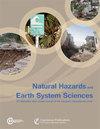中国大陆供水系统地震风险评估模型研究
IF 4.2
2区 地球科学
Q1 GEOSCIENCES, MULTIDISCIPLINARY
引用次数: 0
摘要
摘要利用中国地震危险性概率分析方法计算的四种超限概率下的峰值地加速度(PGA),通过拟合康奈尔地震危险性超限概率 PGA 函数模型,得到了峰值地加速度的概率密度函数。结合实际震害经验矩阵和固定资产暴露计算的供水系统地震脆性函数,建立了供水系统预期地震损失和预期损失率模型,提出了以供水系统预期地震损失率为指标的分类标准。对供水系统的地震脆性进行了分类,分析了供水系统的暴露程度。以《城市供水统计年鉴》(以下简称《供水年鉴》)中的固定资产总值作为该地区的地震暴露值。本文脆性模型的准确性通过德阳的实际地震破坏损失得到了验证。以中国大陆 720 个城市的供水系统为例,计算并绘制了预期地震损失分布图和预期损失率分布图。预期损失率模型经中国大陆地震重点防御区验证。基于预期损失和预期损失率的评估模型被作为中国大陆供水系统地震风险评估模型。本文章由计算机程序翻译,如有差异,请以英文原文为准。
Study on seismic risk assessment model of water supply systems in mainland China
Abstract. Using the peak ground acceleration (PGA) under four exceedance probabilities calculated via a probabilistic seismic hazard analysis method for China, the probability density function of PGA was obtained by fitting with the Cornell seismic hazard exceedance probability PGA function model. Combined with the seismic fragility function of the water supply system calculated on the basis of the empirical matrix of actual earthquake damage and the exposure of fixed assets, the expected seismic loss and expected loss rate models of the water supply system were established, and the classification standard with the expected seismic loss rate of the water supply system as the index was proposed. The seismic fragility of the water supply system was classified, and the exposure of the water supply system was analyzed. The total fixed assets in the Statistical Yearbook of Urban Water Supply, henceforth called Water Supply Yearbook, were taken as the exposure to earthquake in the region. The accuracy of the fragility model in this paper was verified through the actual earthquake damage losses in Deyang. Taking the water supply system of 720 cities in mainland China as an example, the distribution maps of expected seismic loss and expected loss rate were calculated and drawn. The expected loss rate model was verified by the key earthquake prevention areas in mainland China. The assessment model based on the expected loss and expected loss rate was taken as the seismic risk assessment model of water supply systems in mainland China.
求助全文
通过发布文献求助,成功后即可免费获取论文全文。
去求助
来源期刊
CiteScore
7.60
自引率
6.50%
发文量
192
审稿时长
3.8 months
期刊介绍:
Natural Hazards and Earth System Sciences (NHESS) is an interdisciplinary and international journal dedicated to the public discussion and open-access publication of high-quality studies and original research on natural hazards and their consequences. Embracing a holistic Earth system science approach, NHESS serves a wide and diverse community of research scientists, practitioners, and decision makers concerned with detection of natural hazards, monitoring and modelling, vulnerability and risk assessment, and the design and implementation of mitigation and adaptation strategies, including economical, societal, and educational aspects.

 求助内容:
求助内容: 应助结果提醒方式:
应助结果提醒方式:


